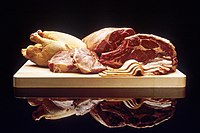
Photo from wikipedia
Abstract Structural change and efficacy measurements have made Norwegian livestock farming dependent on imported protein-rich components in feed concentrate. The increasing global demand and competition for stable protein sources has… Click to show full abstract
Abstract Structural change and efficacy measurements have made Norwegian livestock farming dependent on imported protein-rich components in feed concentrate. The increasing global demand and competition for stable protein sources has spurred a new debate on food security and utilization of local resources. Certain local species have been identified as promising alternatives to imported sources because of their high level of proteins, such as legumes and seaweed. In Norway, the use of seaweed as both food and feed has historical roots reaching back to the Viking age. To replace or reintroduce local protein sources requires substantial and long-term investments in both competence, technology and market mechanisms. At the same time, the unstable situation in global markets for protein rich feed components, makes the vision of sustainable local protein sources difficult to refuse. Little is known, however, about large scale and sustainable manufacturing and distribution of concentrate based on these local resources, nor of farmers' willingness or ability to make use of these resources. This paper seeks to identify and explain sheep farmer's perceptions towards the vision of increasing the use of local protein sources in arctic sheep farming. Based on in-depth interviews with active and retired sheep farmers in coastal and inland Northern Norway, we have explored the dynamic relationship between biophysical and political conditions for farming, and the farmers' willingness and capacity to adapt to new and alternative sustainable practises. Through narrative analyses of farmers' storylines four archetypes were co-constructed, that each explain critical dimensions to farmers' perceptions towards increased use of local protein sources. Building upon insights from adaptive capacity literature and social embeddedness theory, the study shows how farmers' meet these limiting conditions through proactive or reactive responses. The archetypes can inform the wider debate on sustainable feeding regimes at various scales, by revealing context-dependent and endogenous factors that shape farmers responses to change.
Journal Title: Journal of Rural Studies
Year Published: 2018
Link to full text (if available)
Share on Social Media: Sign Up to like & get
recommendations!